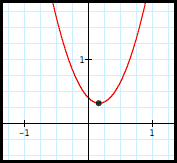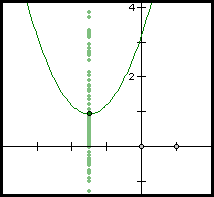
Quadratic Functions
|
|
Again, consider the quadratic function
f(x) = ax2 + bx + c
Suppose a and b are constant, and let c vary.
What does the locus of the vertex look like as c varies?
Make a conjecture about some properties of the equation describing the locus of the vertex as c varies. What shape is the locus? How do a and b figure into the equation?
Now that you've made a conjecture, let's rigorously determine an equation for the locus of the vertex as c varies.
We have shown that the vertex of the parabola is located at
Let
Note that, since a and b are constant,
And y can be anything, since c is varying.
Thus, the locus of the vertex as c varies is
Does this match your conjecture?
Click here to see a Graphing Calculator animation as c varies,
|



 . This is the x-coordinate of the vertex.
. This is the x-coordinate of the vertex.
